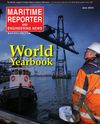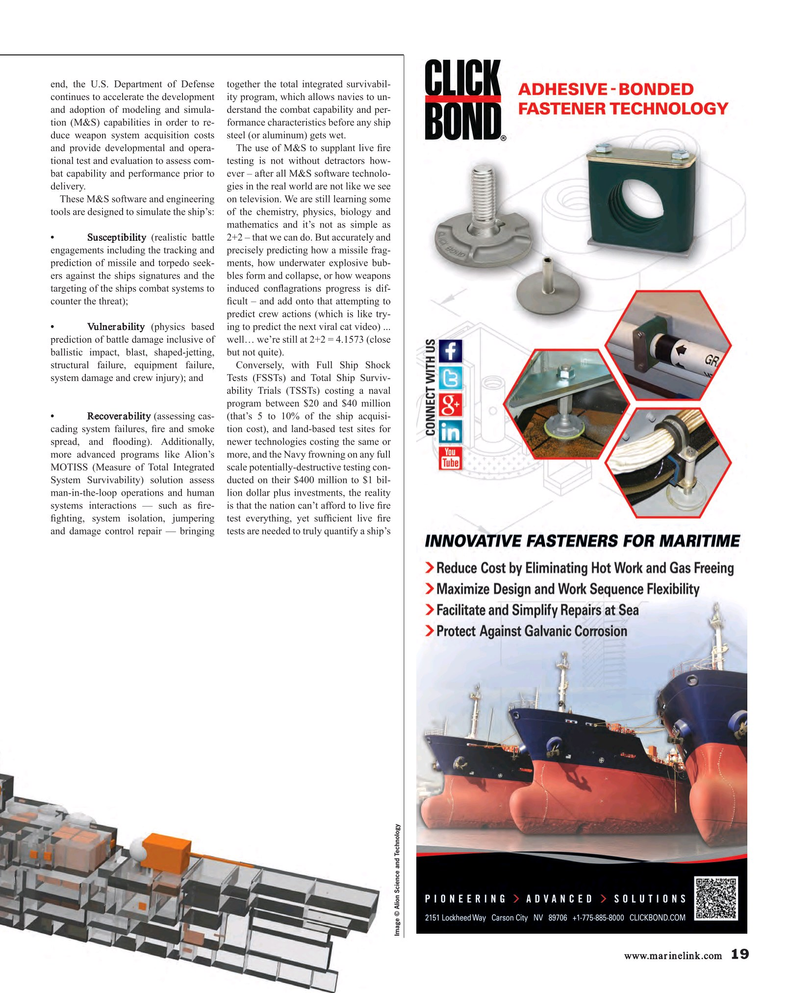
Page 19: of Maritime Reporter Magazine (June 2015)
Annual World Yearbook
Read this page in Pdf, Flash or Html5 edition of June 2015 Maritime Reporter Magazine
end, the U.S. Department of Defense together the total integrated survivabil- continues to accelerate the development ity program, which allows navies to un- and adoption of modeling and simula- derstand the combat capability and per- tion (M&S) capabilities in order to re- formance characteristics before any ship duce weapon system acquisition costs steel (or aluminum) gets wet.
and provide developmental and opera- The use of M&S to supplant live ? re tional test and evaluation to assess com- testing is not without detractors how- bat capability and performance prior to ever – after all M&S software technolo- delivery. gies in the real world are not like we see
These M&S software and engineering on television. We are still learning some tools are designed to simulate the ship’s: of the chemistry, physics, biology and mathematics and it’s not as simple as • Susceptibility (realistic battle 2+2 – that we can do. But accurately and engagements including the tracking and precisely predicting how a missile frag- prediction of missile and torpedo seek- ments, how underwater explosive bub- ers against the ships signatures and the bles form and collapse, or how weapons targeting of the ships combat systems to induced con? agrations progress is dif- counter the threat); ? cult – and add onto that attempting to predict crew actions (which is like try- • Vulnerability (physics based ing to predict the next viral cat video) ... prediction of battle damage inclusive of well… we’re still at 2+2 = 4.1573 (close ballistic impact, blast, shaped-jetting, but not quite). structural failure, equipment failure, Conversely, with Full Ship Shock system damage and crew injury); and Tests (FSSTs) and Total Ship Surviv- ability Trials (TSSTs) costing a naval program between $20 and $40 million • Recoverability (assessing cas- (that’s 5 to 10% of the ship acquisi- cading system failures, ? re and smoke tion cost), and land-based test sites for spread, and ? ooding). Additionally, newer technologies costing the same or more advanced programs like Alion’s more, and the Navy frowning on any full
MOTISS (Measure of Total Integrated scale potentially-destructive testing con-
System Survivability) solution assess ducted on their $400 million to $1 bil- man-in-the-loop operations and human lion dollar plus investments, the reality systems interactions — such as ? re- is that the nation can’t afford to live ? re ? ghting, system isolation, jumpering test everything, yet suf? cient live ? re and damage control repair — bringing tests are needed to truly quantify a ship’s Image © Alion Science and Technology www.marinelink.com 19
MR #6 (18-25).indd 19 MR #6 (18-25).indd 19 6/9/2015 10:23:54 AM6/9/2015 10:23:54 AM

 18
18

 20
20
